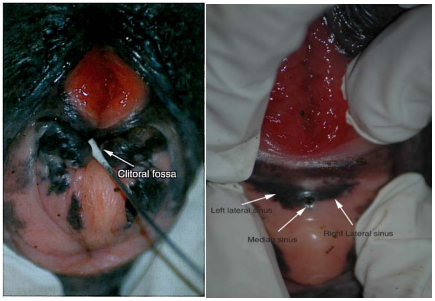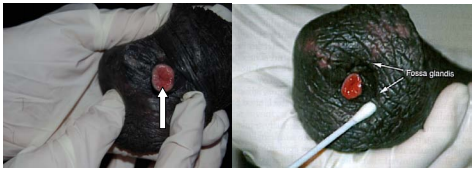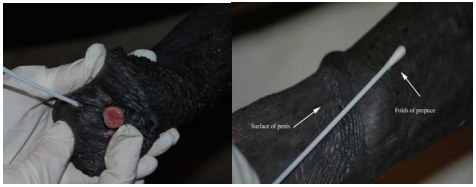Culturing Technique for Contagious Equine Metritis
Materials needed per culture instance
Mare
- 2 Amies Transport Collection and Transport System with Charcoal
- 1 Minitip Amies Transport Collection and Transport System with Charcoal (orange cap)
- 1 Guarded 25” swab (Tiegland or other brand)
Stallion
- 4 Amies Transport Collection and Transport System with Charcoal
Mare
Protocols vary for import, export or disease trace-back purposes, as well as
for open or pregnant mares. Check with regulatory agency for requirements.
The endometrium is cultured while the non-pregnant mare is in estrus - or true anestrus. The external os
of the cervix is cultured when the mare is pregnant or the cervix cannot be penetrated. Three samples may be required from each mare.
- Clitoral fossa – use standard swab with Amies culture and transport system
- Clitoral sinuses swabbed – use Minitip Amies culture and transport system. Openings to the sinuses are on the dorsum of the clitoris - the central one is usually always present whereas the lateral sinuses may be multiple or not be present. Swab all that are present.
- Either cervical (closed cervix if pregnant or mid-cycle) or endometrial (while in estrus or true anestrus) swab – use guarded 25” swab.
Technique

Figure 2 (right): Clitoral Sinuses (left to right: left lateral sinus, median sinus, and right lateral sinus)
- Adequately restrain the mare. Culturing the clitoral sinuses requires excellent restraint of the mare and lighting of the area.
- Wear a new pair of disposable gloves for each mare.
- Bandage tail with clean 3 or 4 inch gauze bandage, place in a clean disposable obstetric sleeve and hold side of mare. Dispose and use new material on each mare.
- Do not wash external genitalia unless evidence of severe soiling. Use only sterile saline and cotton to clean. Do not use common working clothes, sponges or buckets. Use disposable plastic bags as pail liners and cotton. Disinfectants may kill the CEM organism.
- Culture the clitoral fossa first – with an 8-inch sterile swab. Place swab into Amies transport media with charcoal and label.
- Culture the clitoral sinuses next, utilizing a sterile minitip swab on an aluminum wire shaft. Place the swab in Amies transport media with charcoal and label.
- Culture the cervix (closed cervix, pregnant or mid-cycle) or endometrium with guarded swab, if the mare is in estrus or true anestrus. Culture either through sterile, disposable, plastic speculum or by passing the swab by hand, protected with a new clean disposable plastic obstetrical sleeve. Sterile lubricating gel should be applied to the speculum or the back of the glove so as not to contaminate the culture. Do not use lubricants containing disinfectants or antiseptics or known to be spermicidal. Break or cut off the swab into Amies transport media and label.
Stallion
Protocols vary for import, export or disease trace-back purposes. Check
with regulatory agency for requirements.
Four samples may be required from the stallion. Teasing will be necessary for extension of the penis from the prepuce.
- Distal urethra (also called urethral process, distal end of urethra, tip of urethra)
- Fossa glandis (also called preputial fossa, urethral fossa)
- Urethral sinus (also called urethral diverticulum, diverticulum of the glans penis, diverticulum of the fossa glandis)
- Shaft of Penis and Prepuce (also called folds of prepuce, surface of folds of penis)
For export, requirements may vary and may include cultures of pre-ejaculatory fluid or semen.
Technique

Figure 4 (right): Preputial fossa or fossa glandis
- The stallion must be teased so that the penis is erect.
- Wear new gloves for each stallion to be sampled.
- Approach the stallion from the same side that the handler is standing on. Approach from the shoulder area, staying close to the stallion and forward from the hind leg. Adequate restraint may include a stallion shank, lip twitch, tranquilization, or sedation.
- Do not wash external genitalia unless evidence of severe soiling. Use only sterile saline and cotton to clean. Do not use common working clothes, sponges or buckets. Use disposable plastic bags as pail liners and cotton. Disinfectants may kill the CEM organism.
-
The extended penis (usually mild teasing needed) is held in one hand just behind the glans penis.

Figure 5 (left): Urethral sinus or preputial diverticulum
Figure 6 (right): Surface of penis and folds of prepuce - Distal urethra – swab the orifice of the urethral process (distal end of urethra, not into orifice of urethra). Place swab into Amies transport medium with charcoal and label.
- Fossa glandis – swab the fossa 360 degrees around the urethral process (area immediately encirling urethra). Place swab into Amies transport medium with charcoal and label.
- Urethral sinus – swab into the urethral diverticulum (small diverticulum or opening dorsal to the urethral process). Place swab into Amies transport medium with charcoal and label.
- Shaft of Penis and Prepuce – with the penis still extended, swab the reflected preputial mucosal surface near the base of the penis (area distal to preputial ring; this area would be inside the sheath when the penis is not erect). Place swab into Amies transport medium with charcoal and label.
Submit
Refrigerate labeled (Animal ID, site, date and time cultured on each sample) Amies transport media vials containing swabs (do not freeze), and send with refrigerated transport packs in a styrofoam shipper so that culture is set-up within 48 hours of taking the swab (48-hour requirement is Federal Law). Older samples will be rejected by the laboratory as unfit. The laboratory is closed from Saturday at noon and Sunday. Plan early week shipping. Culturing for the CEM organism takes 7 days from the time of placing the materials on the selective culture media. The laboratory cannot release results of negative status before 7 days (7 day requirement is Federal Law). The notification of fungal or bacterial contamination which would preclude reading of the test, will be done as early as possible so that re-sampling and resubmission can take place.
Note
- Amies culture and transport systems with charcoal are available from the Animal Health Diagnostic Center (607-253-3938).
-
Call to pre-schedule
Phone: 607-253-3938



